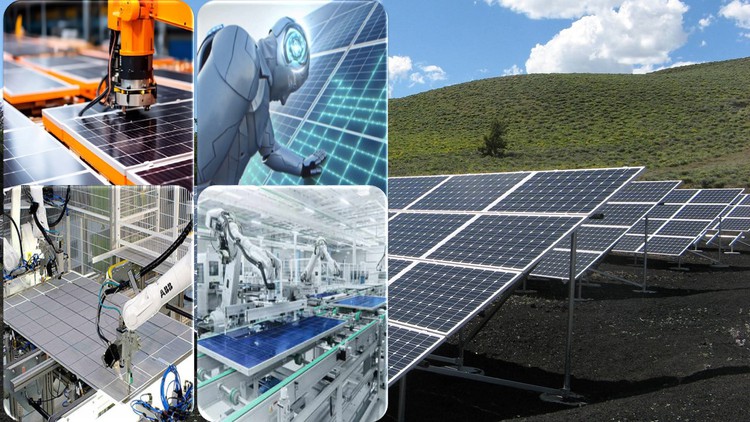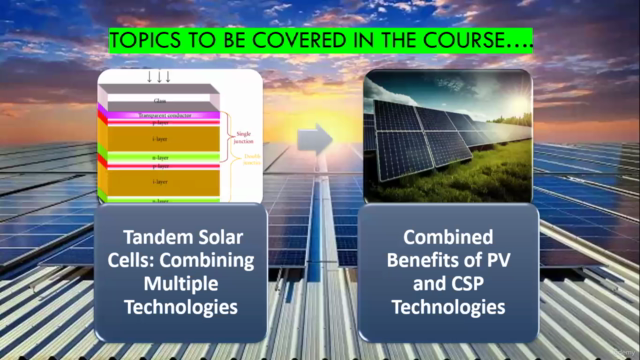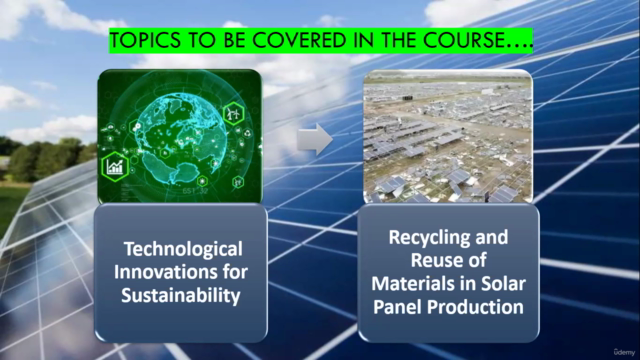Advanced Solar Panel Technologies

Why take this course?
-
Fent Development in Polymer-based Solar Cells:
- Material Research: Ongoing research into new polymer materials that can absorb a broader range of the solar spectrum and have improved stability and efficiency.
- Device Architecture: Innovations in the design of polymer solar cells, such as bulk heterojunction (BHJ) architecture, to enhance performance.
- Challenges: Solubility issues, environmental stability, charge transport limitations, and long-term degradation are some challenges that need to be addressed.
-
Pervoskite-based Solar Cells:
- Performance Improvements: Recent advancements have shown perovskite solar cells achieving efficiencies close to 25%, with ongoing research focused on improving stability and scalability.
- Tandem Configurations: Development of tandem perovskite solar cells, which can potentially reach over 30% efficiency.
- Cost-effectiveness: Pervoskite solar cells are promising due to their lower manufacturing costs compared to traditional silicon-based cells.
-
Recent Development in Dye Sensitized Solar Cells (DSSC):
- Material Innovations: Research into new dyes and electrode materials to improve the efficiency and stability of DSSCs.
- Scalability: Efforts to scale up DSSC production while maintaining cost-effectiveness and performance.
- Hybrid Systems: Integration with perovskite or other technologies to enhance overall solar-to-electric energy conversion efficiency.
-
CIGS (Copper Indium Gallium Selenide) Solar Cells:
- Manufacturing Techniques: Advancements in deposition techniques, such as co-sputtering and multi-stage vapor deposition, to improve the performance of CIGS solar cells.
- Tandem Configurations: Research into CIGS/CZTS or CGS tandem solar cells to increase overall efficiency.
- Efficiency Record: CIGS solar cells have achieved efficiencies over 22% and continue to be a leading thin-film technology.
-
Recent Development in Organic Solar Cells:
- Hybrid Approaches: Combining organic photovoltaics (OPVs) with inorganic materials, such as perovskites, to enhance performance and stability.
- Roll-to-roll Manufacturing: Advances in manufacturing techniques that allow for low-cost production of organic solar cells.
- High-Efficiency Organic Solar Cells: Achieving efficiencies above 15% with new materials and device designs.
-
Concentrated Solar Power (CSP) Systems:
- Thermal Storage Innovations: Improved thermal storage solutions that allow for energy storage and dispatch.
- Advanced Mirror Technologies: Development of lightweight, durable mirrors for solar field applications.
- Hybrid Systems: Integration with photovoltaic systems to enhance overall efficiency and reliability.
-
Tandem Solar Cells:
- Two-Junction Tandem Solar Cells: These cells use two different layers, each tuned to capture different parts of the solar spectrum.
- Three-Junction or Four-Junction Tandem Solar Cells: Further increasing the number of junctions to capture more of the solar spectrum and improve efficiency.
- Perovskite-Silicon Tandems: Combining perovskite layers with silicon for high efficiency and cost-effectiveness.
-
Advantages of Tandem Solar Cells:
- Efficiency Boost: Significantly higher power conversion efficiencies compared to single-junction solar cells.
- Spectrum Utilization: Ability to utilize a broader range of the solar spectrum, increasing the amount of harvested sunlight.
- Scalability: Potential for large-scale production and integration with existing solar technologies.
-
Printing Techniques in Solar Cell Manufacturing:
- Screen Printing: A common technique for manufacturing CIGS and other thin-film solar cells due to its low cost and ease of use.
- Gravure and Offset Printing: These methods are used for large-area coverage with precise material deposition.
- Inkjet and 3D Printing: Emerging techniques that offer flexibility, customization, and potentially lower costs for solar cell production.
-
Atomic Layer Deposition (ALD) and Chemical Vapor Deposition (CVD):
- ALD: Offers precise control over thin-film materials at the atomic level, ideal for high-performance solar cells.
- CVD: Used for growing semiconductor layers, such as silicon or gallium arsenide, with a high degree of uniformity and purity.
-
3D Printing Applications in Solar Panel Production:
- Complex Geometries: Enables the manufacturing of solar panels with complex structures for improved performance and light trapping.
- Customization and Repair: Allows for on-site customization and potential repairs of solar panels without replacing entire modules.
-
Industry 4.0 in Solar Manufacturing:
- Smart Factories: Implementation of IoT, AI, and machine learning to optimize production processes and reduce waste.
- Digital Twin Technology: Virtual models that simulate the manufacturing process to predict and solve potential issues before they occur.
-
Global Manufacturing Hubs in Solar Industry:
- China: A leading manufacturer of solar cells, particularly silicon-based and thin-film technologies like CIGS.
- United States: Home to significant research and development in advanced solar technologies, including perovskites and tandem solar cells.
- Germany, Japan, and South Korea: Also key players in the production of high-efficiency and innovative solar technologies.
Each of these areas represents a critical aspect of the ongoing evolution of solar technology. The industry's focus on innovation, efficiency, cost reduction, and scalability is driving the adoption of renewable energy sources worldwide.
Course Gallery




Loading charts...